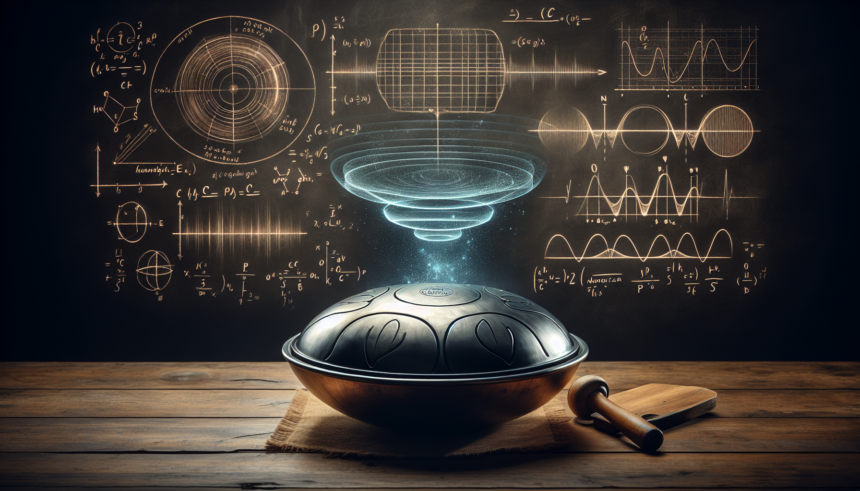The handpan, characterized by its UFO-like shape and celestial sound, has captured the fascination of musicians and music lovers alike. But what lies beneath its enchanting timbre, and what makes it resonate so richly? To uncover the science behind the sound, let’s delve into the world of harmonics, metal crafting, and acoustic physics that combine to create this unique instrument’s powerful and emotive sound.
The Anatomy of a Handpan
A handpan is typically made from two convex steel shells glued together to form a hollow structure. The top shell, known as “the dome,” contains several notes, each tuned to a specific frequency. The bottom shell is largely plain with a central hole, which helps to project sound and maintain resonance.
The central note is called the “ding,” and it is the lowest note on the handpan. Surrounding the ding are other notes that follow a specific musical scale. Each note zone, often shaped like oval dents, produces a primary tone as well as a series of overtones or harmonics. This harmonic richness is key to the handpan’s mesmerizing soundscape.
Understanding Harmonics
To comprehend the magic of handpan harmonics, it’s crucial to understand what harmonics are. Harmonics, or overtones, are frequencies that are integer multiples of a fundamental frequency. For instance, if you pluck a string that vibrates at a fundamental frequency of 100 Hz, it also vibrates at frequencies of 200 Hz, 300 Hz, and so on. These additional frequencies give the sound its unique color or timbre.
Hammering and Tuning: Crafting Harmonics
The creation of a handpan is a meticulous art that involves expertly hammering the metal into the desired shape and then fine-tuning each note. The hammering process induces stress and strain in the metal, which helps to establish the fundamental and overtone frequencies for each note zone. This delicate interplay between metalwork and acoustic tuning requires a keen ear and skilled hands.
A seasoned handpan maker, or “tuner,” skillfully manipulates each dent to coax and enhance the desired harmonic spectrum. By adjusting the curvature, thickness, and tension of the metal, the tuner can emphasize certain overtones. This precision tuning is what gives each handpan its unique voice and harmonic richness.
Acoustics and Resonance
When a handpan is struck, the energy is transmitted through its metal body, creating vibrations that then resonate within the hollow structure. This resonance amplifies both the fundamental frequencies and their harmonics, creating a rich tapestry of sound. The presence of the central hole or “port” on the bottom shell plays a pivotal role as well, allowing air to move in and out, which helps to sustain and project the sound more effectively.
The material of the handpan also contributes to its acoustic properties. Most handpans are constructed from nitrided steel, which undergoes a specialized heat treatment to enhance its durability and resonance. This treatment contributes to the instrument’s ability to sustain notes and produce a wide range of harmonics.
Psychoacoustic Effect of Handpan Harmonics
Beyond the physics, the handpan’s harmonics have a profound psychoacoustic effect on the listener. The layering of harmonics creates a sense of spatial depth and complexity, which can be deeply moving and meditative. This is why the handpan is often used in therapeutic and spiritual contexts. The interplay of multiple overtones engages the brain in a unique way, often inducing a state of relaxation or heightened emotional sensitivity.
Harmonics also contribute to the “ethereal” quality often attributed to the handpan. The interaction of these multiple frequencies can create binaural beats or other auditory illusions, which further enhance the instrument’s mystical aura.
Playing Techniques and Harmonics
The way a handpan is played also harnesses its harmonic capabilities. Different striking techniques can emphasize various overtones, allowing players to craft their sonic landscape. Gentle, fingertip strikes tend to bring out higher harmonics, while more forceful strikes emphasize the fundamental tones. Skilled players use a combination of techniques to create dynamic, evolving musical phrases that highlight the instrument’s full harmonic potential.
The Future of Handpan Harmonics
As handpan crafting continues to evolve, new materials and techniques are being explored to enhance harmonic richness further. Innovations such as hybrid materials (combining metal with other resonant substances) or electronic augmentation (using pickups and effects) are opening new horizons in the world of handpan music. These advancements promise to unlock even greater harmonic possibilities, expanding the instrument’s expressive range and adaptability.
Conclusion
Handpan harmonics are an intricate blend of material science, acoustic physics, and musical artistry. From the careful crafting and tuning process to the nuanced playing techniques, every element contributes to the instrument’s distinctive and mesmerizing sound. The interplay of fundamental tones and overtones creates a rich, harmonic tapestry that resonates deeply with listeners, making the handpan a truly unique and emotionally powerful instrument.
FAQs
1. What is a harmonic on a handpan?
A harmonic is an overtone frequency that is a multiple of the fundamental frequency produced by striking a note on the handpan. These overtones add complexity and richness to the sound, creating the instrument’s distinctive timbre.
2. How are harmonics created on a handpan?
Harmonics are created through the precise hammering and tuning of the handpan’s metal surface. By manipulating the curvature, thickness, and tension of the metal in each note zone, craftsmen can enhance specific overtone frequencies.
3. Why is nitrided steel used for handpans?
Nitrided steel undergoes a special heat treatment that makes it more durable and enhances its acoustic properties. This type of steel helps the handpan produce sustained notes and a wide range of harmonics.
4. Can electronic augmentation affect handpan harmonics?
Yes, electronic augmentation such as pickups and effects can add new dimensions to the handpan’s harmonic spectrum. These technologies can amplify certain overtones or add entirely new layers of sound.
5. Why do handpan harmonics have a meditative effect?
The rich interplay of multiple harmonics engages the brain in a unique way, often inducing a state of relaxation or heightened emotional sensitivity. This psychoacoustic effect contributes to the handpan’s use in therapeutic and spiritual contexts.





